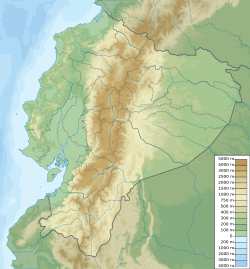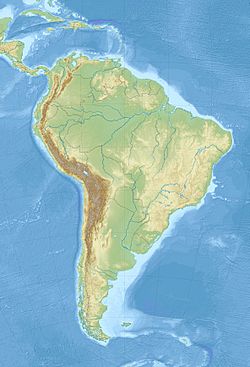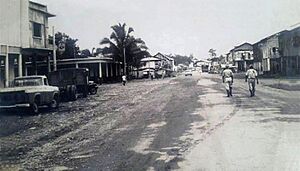Valencia, Ecuador facts for kids
Quick facts for kids
Valencia
|
|||
|---|---|---|---|

Entrance to Valencia
|
|||
|
|||
| Nicknames:
"Jardín de Los Ríos (Los Ríos Garden)"
|
|||
| Country | Ecuador | ||
| Province | Los Ríos | ||
| Canton | Valencia Canton | ||
| foundation | 13 December 1995 | ||
| Named for | Gregorio Valencia | ||
| Urban parishes | 3 urban parishes | ||
| Government | |||
| • Type | Mayor and council | ||
| Area
(approx.)
|
|||
| • City | 6.09 km2 (2.35 sq mi) | ||
| Elevation | 105 m (344 ft) | ||
| Population
(2022 census)
|
|||
| • City | 22,996 | ||
| • Density | 3,776/km2 (9,780/sq mi) | ||
| • Demonym | Valenciano | ||
| Time zone | UTC−5 (ECT) | ||
| Postal code |
EC121150
|
||
| Area code(s) | (0)5 | ||
| Languages | Spanish | ||
| Climate | Aw | ||
| Website | http://www.valencia.gob.ec/ | ||
Valencia is a city in Ecuador. It is the main city of the Valencia Canton and the sixth largest city in the Los Rios Province. Valencia is located in the central-north part of Ecuador's coastal region. It sits on a large flat area near the western Andes mountains. The city is about 105 meters (344 feet) above sea level. It has a tropical climate with an average temperature of 26 °C (79 °F).
Contents
How Valencia Got Its Name
The name Valencia comes from the year 1887. A man named Gregorio Valencia settled near a small river, called an estuary. He was known for his special abilities, and people in the area knew him well. Because of him, the estuary became known as "Estero Valencia." Over time, the small village that grew there also took on the name Valencia.
Geography and Climate
Where Valencia Is Located
The land in Valencia is slightly raised, about 60 meters (197 feet) above sea level. Several important rivers flow through this area. These include the San Pablo, Quindigüa, Lulo, and Manguila rivers. During the rainy season, these rivers can become very strong and full.
Valencia's Weather
Valencia has a tropical climate. This means it is warm all year round. Temperatures usually stay between 20 °C (68 °F) and 32 °C (90 °F). Valencia is in a subtropical zone, which explains its warm and often rainy weather.
History of Valencia
Long ago, before the Los Ríos Province was created, there was a town here. It was home to the Colorado Indians and was called San Pablo. This town was located along the Pilaló River. When San Pablo de los Colorados was destroyed, its people moved to different places along the river.
Eventually, they settled in an area that was part of the Chicoleado farm. The people worked to make this area its own parish (a small local district). On August 16, 1944, Valencia officially became a parish. At that time, it was part of the Quevedo canton. Later, on December 29, 1995, Valencia became its own canton. This was made official by the government of President Sixto Durán Ballén. However, local leaders decided to celebrate the city's special day on December 13 each year.
Valencia's Economy
Valencia is an important area for farming and business. The canton has many factories that pack bananas and process other crops. Farmers in Valencia grow a wide variety of products. These include African palm, bananas, cocoa, soybeans, and coffee. They also grow plantains, rice, corn, and passion fruit. Many different kinds of citrus and tropical fruits are also grown here. Besides farming, raising livestock (like cattle) is also a big part of the economy.
Population and Growth
Valencia is a city in the Los Ríos Province of Ecuador. In 2010, about 16,983 people lived there. A large number of Valencia's residents, about 60 percent, have moved there from other parts of Ecuador. Valencia is close to the city of Quevedo. Because of this, Valencia is part of the larger Quevedo metropolitan area. This area includes several cantons like Quevedo, Mocache, Buena Fe, and Valencia in Los Ríos. It also includes El Empalme in Guayas, Pichincha in Manabí, and La Maná in Cotopaxi. This makes it one of the fastest-growing metropolitan areas in Ecuador.
Culture and Traditions
Valencia has many interesting traditions. One of the most popular traditions is the annual bullfighting fair. This fair is considered one of the best in the Los Ríos Province. It takes place every year in early October. The fair celebrates the city's patron saint, San Francisco de Asís.
Local Food
When you visit Valencia, you can try some delicious local dishes. Some of the most typical foods include Hornado (roasted pork), tilapia fish, and "hose broth." The city also has a well-organized market. Here, you can find all sorts of fresh vegetables, beans, and fruits. These products come from both the coast and the mountains of Ecuador.
Sports in Valencia
Football (Soccer)
Football is a popular sport in Valencia. Two local teams, Club Deportivo Napoli and Club Deportivo Montry, play in the Los Ríos Second Category Provincial Championship. This is a local football league.
The main place for playing football in Valencia is the 'Municipal Stadium of Valencia'. This stadium is mostly used for soccer games. It can hold up to 5,000 people. The stadium also hosts other sports events and cultural shows, like music concerts.
City Divisions
The city of Valencia is divided into three main parts, called urban parishes:
- La Unión
- Nueva Unión
- Valencia
See also
 In Spanish: Valencia (Ecuador) para niños
In Spanish: Valencia (Ecuador) para niños







